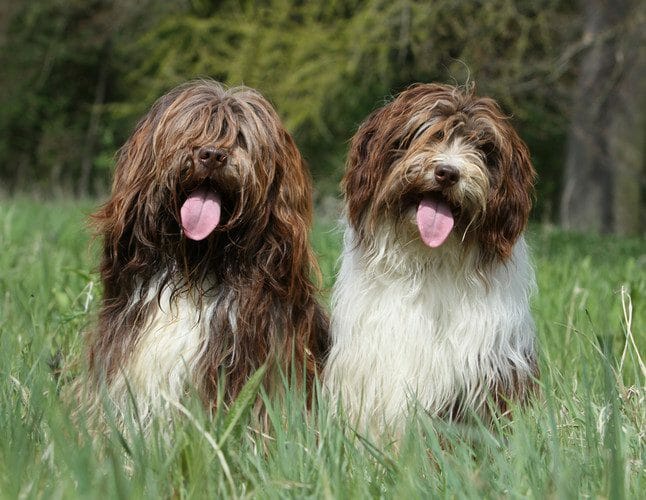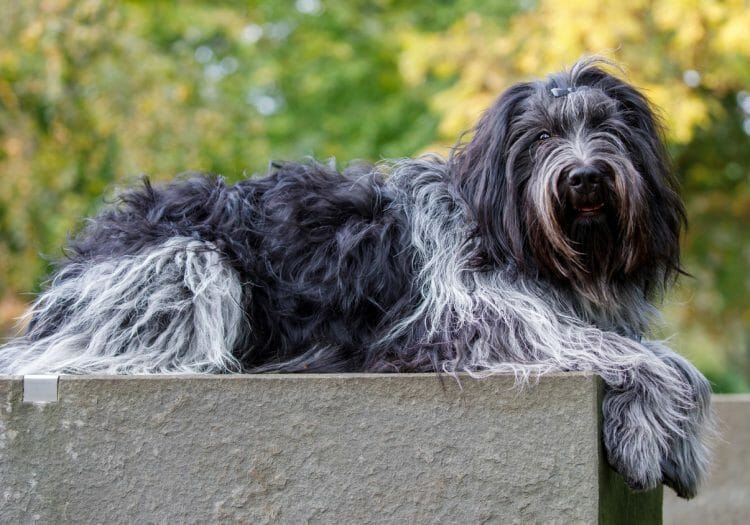Schapendoes

Schapendoes History
The Dutch Schapendoes is a herding dog that originated from the Netherlands. Schapendoes are commonly known as the Dutch Sheepdog or even as the “Dog of the Common People.” The breed may have come from the Northeastern Drenthe or the forested Veluwe region of Gelderland. The breed could be found throughout the country during the 19th century.
Historically, Dutch farmers used two types of dogs to manage their flocks. The larger Dutch Shepherd breed would be used to herd the sheep together, while the smaller Schapendoes were the drivers of the flock.
Breeds that are related to the Schapendoes include other European working dogs, such as the Polish Lowland Sheepdog (Owczarek Nizinny), the Bearded Collie, the Old English Sheepdog, the Puli, the Old German Sheepdog, the Komondor, the Bergamasco Shepherd (Cane da Pastore Bergamasco), and the Briard.

During the 1870s, Schapendoes were exhibited in the first Dutch dog shows. However, they were simply referred to as “domestic herding dogs.” Due to the combined impact of World War I and the fact that Border Collies started to be exported to the Netherlands in the 1940s, Schapendoes dogs faced extinction by the end of the Second World War. As a result, considerable efforts were made to rebuild the stock of the breed.
The Dutch national kennel club, Raad van Beheer, formally recognized the breed in 1952. Two years later, the breed standard was written. Since the 1970s, Schapendoes have slowly grown in popularity throughout the globe. In 1989, the Fédération Cynologique Internationale also acknowledged the breed, and the United Kennel Club in the UK first accepted Schapendoe in 2006. To this day, however, the number of Schapendoes remains low.

Schapendoes Temperament
Schapendoes are friendly and amiable dogs that enjoy the company of humans. Although these canines are independent, they are eager to please and respond well to instructions. However, these quick learners do need consistency in their training. Always use positive reinforcement techniques and reward desirable behavior with praise and treats. Training should start immediately if good habits are to be taught.
In the fields, the Schapendoes control the flock by gently nudging them using its nose. This technique is one that these dogs often apply to humans, particularly children. In fact, these dogs may try and herd anyone it meets!
Socialization is important to ensure the Schapendoes’ natural protective and suspicious guardian instincts are kept under control. Introduce the Schapendoes to as many new people and animals as possible to teach them about the world. Training classes are a great way to achieve this.
Energetic and playful, Schapendoes get on well with children and enjoy games and performing tricks. As a herding dog, it does tend to bark, particularly when bored. Providing plenty of opportunities for exercise and activity will help stimulate these canines, reducing the risk of boredom. As with most dog breeds, Schapendoes puppies will require effort and training. However, a good-natured dog is always the product of its socialization, environment, and training.

Schapendoes Size and Appearance
The medium-sized Schapendoes has a long shaggy coat that covers its body, face, ears, tail, and legs. It has small ears that hang down and a bearded face. Schapendoes stand between 16 and 20 inches tall. Weights vary from 30 to 40 pounds.
Schapendoes Colors
These canines may either be a solid color with white or tricolor. Common colors include:
- Black
- Brown
- Beige
- White
- Gray

Schapendoes Health
There are very few genetic health concerns that owners need to be aware of when it comes to this well-established hardy breed of working dogs. Understanding the conditions that may affect the Schapendoes will make it easier to spot them and get treatment early. Some of the conditions look for are ear infections, progressive retinal atrophy, and hip dysplasia. A bit about each of these conditions is described below.
Ear Infections
Ear infections can be fungal or bacterial and may be caused by moisture trapped in the ear canal, a build-up of earwax, or endocrine gland disorders.
Signs that a dog has an infection are dark visible discharge around the ears, repeated scratching around the area, and constant shaking of the head.
Treatment may be topical or oral medications. Cleaning the ears often helps the healing process.
Progressive Retinal Atrophy
Progressive Retinal Atrophy (PRA) is a degenerative condition that affects the photoreceptor cells in the eyes. If these rod- and cone-shaped cells develop abnormally, it can cause night blindness. Over time, the dog’s eyesight will worsen, and it will eventually cause complete blindness.
The condition usually affects younger dogs and is called retinal dysplasia. However, a late-onset version of PRA may damage the eyesight of older canines.
Early signs that a dog has PRA are that it becomes anxious in the dark or starts to bump into things. A specialist veterinary ophthalmologist will need to diagnose the condition. There is currently no treatment.

Hip Dysplasia
Hip dysplasia is a condition that affects many large- and medium-sized breeds of dogs. The hip joint consists of two bones that form a ball and socket. As a puppy reaches adulthood, these bones may being to develop abnormally, which can lead to mobility issues.
Canines with hip dysplasia may limp or become lame. The condition usually occurs in younger dogs and can be diagnosed by a veterinarian using an X-ray. Corrective surgery is usually the prescribed course of action, and this can restore movement to the joint again.
Schapendoes Lifespan
The typical lifespan of the Schapendoes is between 12 and 15 years. There are several factors that play a role, such as the home environment, exercise, diet, and genetics.
Regular checkups will identify the early signs of any health concerns, allowing a veterinarian to address these promptly. In addition, providing recommended vaccines (such as those for rabies and parvo) will help to ensure good health. GoodPooch also recommends providing preventive medication for fleas, ticks, and heartworm, which will help protect against flea infestations and Lyme disease.
Schapendoes Adoption
Before buying Schapendoes, always look at the option to adopt. Many dogs are given up by their owners because they underestimate their training and care needs or face a change in their circumstances. As a result, adoption centers often have animals in need of a good home. No-kill shelters should always be used as these shelters have a strict policy to never euthanize a healthy dog.



